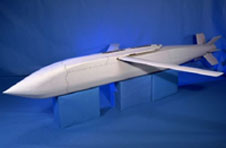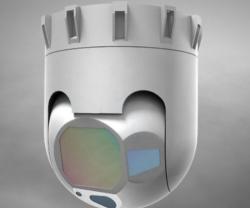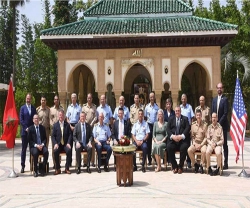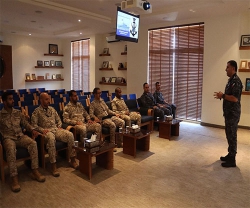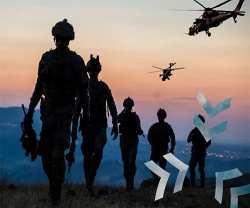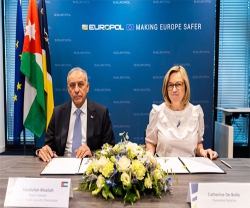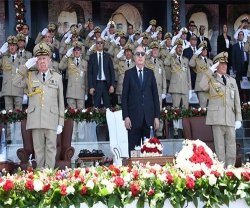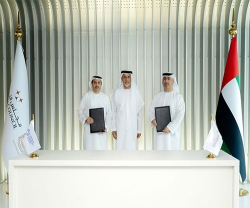US Navy Starts Raytheon’s JSOW C-1 Integrated Testing
23.08.2012 North America
The U.S. Navy has begun Integrated Testing (IT) of Raytheon's Joint Standoff Weapon (JSOW) C-1. During its first flight in IT, the JSOW C-1 was retargeted to strike a large moving ship target.
“This flight test further demonstrates that JSOW C-1 can receive third party target updates in-flight, retarget after release, and strike a precise point on a moving ship using the weapon's autonomous terminal seeker. The program remains on track for reaching initial operational capability in 2013,” said Commander Samuel Hanaki of the U.S. Navy's Precision Strike Weapons Program Office.
The test presented two maneuvering ships (large and small) as potential targets. Before weapon release, a Navy F/A-18F Super Hornet targeted the smaller ship, and then handed off weapon control to a second Super Hornet also targeting the smaller ship. After release from the first Super Hornet, the JSOW C-1 was guided by the second Super Hornet toward the smaller maneuvering ship target located 90 kilometers from launch point.
While in flight, the JSOW was retargeted by the second Super Hornet to the larger maneuvering ship target. The JSOW provided weapon in-flight track and bomb hit indication status messages back to the controlling Super Hornet while successfully engaging the larger target ship. The test validated JSOW C-1's unique ability to be controlled, updated and retargeted as needed to eliminate its intended target.
“JSOW C-1 brings U.S. and allied warfighters the unique ability to engage moving ships as far as 100 kilometers away with an air-launched precision strike weapon. The 280 Raytheon employees in Tucson, Ariz., and the hundreds of partner-supplier employees across the U.S. worked hard to make this test a success and demonstrate JSOW C-1's ability as the newest and pre-eminent moving maritime target weapon,” said Celeste Mohr, Raytheon Missile Systems' JSOW Program Director.
“This flight test further demonstrates that JSOW C-1 can receive third party target updates in-flight, retarget after release, and strike a precise point on a moving ship using the weapon's autonomous terminal seeker. The program remains on track for reaching initial operational capability in 2013,” said Commander Samuel Hanaki of the U.S. Navy's Precision Strike Weapons Program Office.
The test presented two maneuvering ships (large and small) as potential targets. Before weapon release, a Navy F/A-18F Super Hornet targeted the smaller ship, and then handed off weapon control to a second Super Hornet also targeting the smaller ship. After release from the first Super Hornet, the JSOW C-1 was guided by the second Super Hornet toward the smaller maneuvering ship target located 90 kilometers from launch point.
While in flight, the JSOW was retargeted by the second Super Hornet to the larger maneuvering ship target. The JSOW provided weapon in-flight track and bomb hit indication status messages back to the controlling Super Hornet while successfully engaging the larger target ship. The test validated JSOW C-1's unique ability to be controlled, updated and retargeted as needed to eliminate its intended target.
“JSOW C-1 brings U.S. and allied warfighters the unique ability to engage moving ships as far as 100 kilometers away with an air-launched precision strike weapon. The 280 Raytheon employees in Tucson, Ariz., and the hundreds of partner-supplier employees across the U.S. worked hard to make this test a success and demonstrate JSOW C-1's ability as the newest and pre-eminent moving maritime target weapon,” said Celeste Mohr, Raytheon Missile Systems' JSOW Program Director.
Previous PostOshkosh, US Army Commemorate 10,000th FMTV
Latest news
Latest events
IDEF 2025 Turkey - International Defence Industry Fair
22 - 27 Jul 2025Istanbul Expo Center - TurkeyDSEI 2025
09 - 12 Sep 2025Excel, London - United KingdomIntersec Saudi Arabia
29 Sep - 01 Oct 2025Riyadh International Exhibition & Convention Centre - Saudi ArabiaDubai International Air Chiefs’ Conference (DIACC 2025)
16 Nov 2025Atlantis, The Palm Dubai - United Arab Emirates

